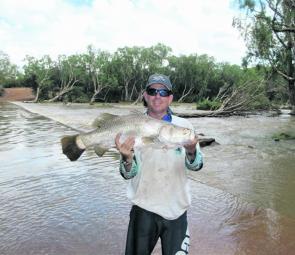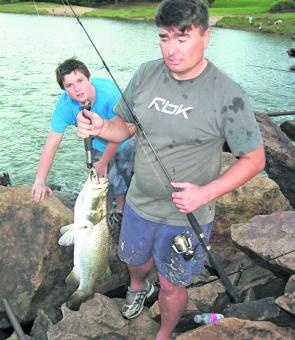So far in the series we’ve covered tropical creek trolling, bankside casting, essential accessories and now we are going to delve a little deeper into the world of casting.
In the bankside casting article we focused on the basics behind barramundi fishing along natural creek banks. In this article we look at draining water and flowing water situations.
In previous articles we recommended using a baitcaster outfit loaded with 30lb braid. This is the ideal all-round outfit for barramundi fishing.
As far as leader goes I’d start with 40lb leader in benign country such as fishing around the outflows of gutters that drain the mudflats on a falling tide. If the fish are generally small and the water clear then I may go down in leader size and if there are oysters and mangrove root tangles then I’m likely to go up to 60lb leader. This heavier leader size is also likely to be my choice if big fish are expected and there is a likelihood of them being difficult to land due to river current or a tricky lift up the bank, wall or bridge.
It’s also worth looking beyond the standard baitcaster outfit and having a go with some light spin gear. There are many benefits to using a good spin reel and a spin rod around two metres in length. I like throwing small lures including soft plastics for barra and threadline spin outfits tend to do that with less complication than baitcaster outfits. This is especially so if you have to cast into the wind. I generally run 20-30lb braid on my spin gear.
When casting from the bank I suggest using a bigger lure for casting distance and to use lures and retrieves that are less likely to snag. I encourage the use of topwater lures especially in low light situations at the start and end of each day when barra have a habit of looking skywards for their food. I do confess that my suggestions here are based on my enjoyment of catching barra off the surface.
However, for pure fish catching intent, fish the big name road crossing spots and employ the full range of diving minnow lures and soft plastic swim baits that the locals use.
When you are boat based, especially if your boat has an electric motor, you can choose to position your boat based on your casting distance and ability. This means that you can get closer to the snags if you desire, hence having the option of using smaller lures with a shorter casting range.
I’ll often go to suspending hardbodied lures when fishing drains and weirs. They regularly cast better and you can fish them in some quite unique situations. Don’t forget lures like the bibless Rat-L-Trap - they sink quickly and get down into the strike zone often without too much nuisance from side currents.
You can also get in amongst the gnarly stuff and fish lead headed soft plastics. Soft plastics can be rigged weedless too. Weedless plastics can get you into some really white-knuckle situations - it’s only a problem if you hook up!
If you snag up you can often move the boat in to the snag and using a lure retriever you stand a good chance of getting your lure back. It’s not that I have a problem with losing lures – it’s that I try not to leave them behind.
Current flow is a key element to catching barra. Current flow could mean just the most miniscule of tidal current in an otherwise still side creek, or it could be a swirling main river king tide run out around the end of a breakwall.
Think like a fish - work out where the baitfish will be and work out how the big fish can attack or ambush the baitfish. Importantly with the bait that barra like to eat I tend to think more about using the current to my advantage and working out how the current relates to the bait.
Tidal runoff that occurs every day as the flats drain on the falling tide. The flats aren’t featureless flat terrain - they’ll have gutters across them through which the water flows out into the main river as the flats drain. These drains amongst the flats are often the last part of the flats to hold water. Drains have at least two phases of peak productivity – the first is when the barra patrol up and down the drains looking for baitfish that are forced off the wider shallower expansive flats. The second is later in the falling tide when the flats are fully exposed and the drains are flushing into the main river – the barra wait in the main river waiting for the inevitable last outflow of water that will often hold quite a few baitfish.
My strategy here is to use 3” shad tail soft plastics rigged on lead heads and to cast and retrieve them along the internal edges of the drain and across the mouths of the drain where they expel into the main creek.
I’ll also fish the same lures across the mouths of side creeks on the falling tide as they drain into the main river. The principles are identical to the techniques of fishing the mouths of the drains as they exit the flats. Cast to the corners and across the flow where the side creek meets the main river.
Incidentally the soft plastic lure that I use most is labelled 4” but it actually measures 3” and this puts it in the same profile as the famous Slider paddle tailed grub. The hint there is that the 3” Slider grub and 3” Double Action are just as good for barra as they are for bass.
At the outflows where the drains meet the big water I have a rule that I’ll vary the depth at which I swim my soft lure, going deeper on successive casts until I build a pattern of where the hungry soft plastic munching barra are. I start with the lure at a depth that I call ‘just outta sight’ - the depth at which I can no longer see the lure. And I go all the way to bumping and hopping off the bottom.
Also if I’m fishing a hard-bodied diving lure and the fish go off the bite I’ll immediately switch to a soft plastic. This has worked for me many times, often the soft plastic is more successful.
Seasonal runoff and post storm runoff is often fished from the bank or from bridges and weirs that cross the main flow of the rivers.
Prime time is often the annual or seasonal runoff where rivers again become fishable after the big wet of summer – anglers wait until the flow slows enough to be fishable but with enough run in the water to have the bait hiding in the eddies and the barra switched on and feeding.
At many of these spots, it’s a matter of joining the crowds - the big fish are legendary and anglers keep coming back for more.
The similarity between tidal flows and seasonal run-off is that the food corralled by the water flow means easy pickings – the dinner bell rings for the awaiting barramundi.
Reads: 8070
Roper Bar, a natural rock crossing separating the saltwater and freshwater sections of the Roper River produced this 82cm barra for ‘Bert’ Cuthbertson.

On a falling tide Steve Bain caught this barra off a snag on the corner of a drain as water flowed into the main creek.

Norm Beer and a Townsville Weir caught barra. After the rain stops and the run-off starts to slow is the time to be there.





